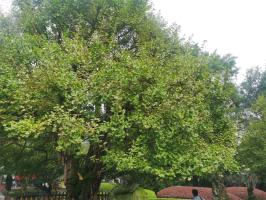How Planting Trees Helps the Environment
Planting trees is a simple yet effective way to combat environmental issues such as deforestation, air pollution, and climate change. Trees serve as the lungs of the earth, producing oxygen and absorbing carbon dioxide, making them an essential part of our ecosystem. Here's how planting trees can help the environment:
Combat Deforestation
Deforestation, the removal of trees from forests to make way for human activities such as agriculture and building, has a severe impact on the environment. Deforestation leads to soil erosion, loss of biodiversity, and negatively impacts the climate. Planting trees is a great way to combat deforestation by replacing what we've lost. While it may take many years for a tree to reach maturity, but eventually leads to a restored forest and the benefits that come with them.
Clean the Air
Air pollution is a significant environmental issue that affects people's health and contributes to climate change. Trees absorb many pollutants from the air, including nitrogen oxide, sulfur dioxide, and carbon monoxide. Trees also help reduce the amount of airborne particles in the air by trapping them on their leaves, which makes the air cleaner and healthier for people to breathe.
Reduce Carbon Footprints
Carbon dioxide is a greenhouse gas that contributes to global warming and climate change. Trees absorb carbon dioxide and other greenhouse gases from the atmosphere, effectively reducing our carbon footprint. When we plant trees, we are not only removing the carbon dioxide already present from the air, but we're also planting for future absorption. According to some estimations, an average mature tree can absorb up to 48 pounds of carbon dioxide per year.
Provide Biodiversity
Biodiversity refers to the variety of life forms in a particular habitat or ecosystem. It is essential for maintaining the balance of the ecosystem and the sustainability of life on earth. Trees serve as habitats for many different species of flora and fauna. By planting trees, we restore and expand habitats, which directly supports the biodiversity of our ecosystem. Trees provide shade, water, and shelter for insects and animals, and nectar and pollen for bees and other pollinators.
Reduce Urban Heat
Urban heat island effect refers to the increase in temperature in urban areas compared to adjacent rural areas. This increase in temperature is caused by the absorption and retention of heat by concrete, asphalt, and other materials used in urban construction. Trees help to reduce the urban heat island effect by providing shade and releasing water through a process called transpiration. In cities, the planting of trees along sidewalks and on streets has been shown to reduce the temperature by several degrees Fahrenheit.
Conclusion
The benefits of planting trees are overwhelming, making tree planting programs an important part of protecting the environment. By planting trees, we can help combat deforestation, clean the air, reduce our carbon footprint, provide biodiversity, and reduce urban heat island effect. So, let's take on this worldwide responsibility and plant trees for our planet!

 how many times do yo...
how many times do yo... how many planted tre...
how many planted tre... how many pine trees ...
how many pine trees ... how many pecan trees...
how many pecan trees... how many plants comp...
how many plants comp... how many plants can ...
how many plants can ... how many plants and ...
how many plants and ... how many pepper plan...
how many pepper plan...






























